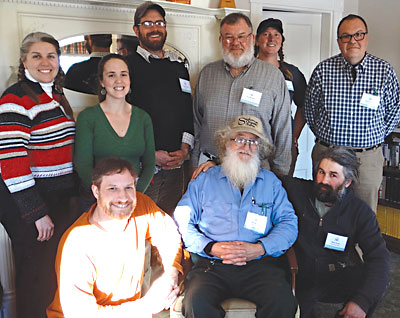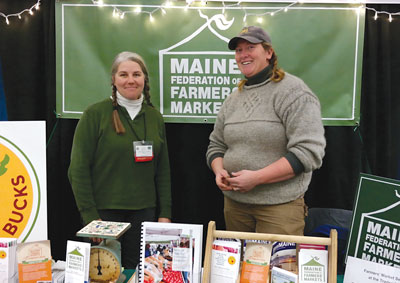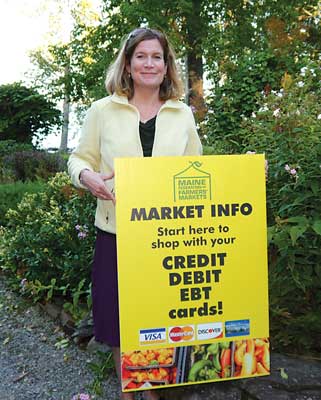 |
| The MFFM board. Front L-R: Mike Gold (Maine Farmland Trust), Tom Roberts (Snakeroot Organic Farm), Mark Guzzi (Peacemeal Farm); Back L-R: Heather Donahue (Balfour Farm), Sherie Blumenthal (St. Mary’s Nutrition Center), Clayton Carter (Fail Better Farm), Jack McAdam (McDougal Orchards), Hanne Tierney (Cornerstone Farm) and Rob Lawless (Took a Leap Farm). Photo courtesy of MFFM |
By Stowell P. Watters
Farming is a sweet and simple thing: Plant seeds, harvest food and people crawl out of the woodwork to get their hands on the product. How wonderful! And how over-simplified!
A farmer is a thousand things, but chiefly he or she is a businessperson. The viability of any farm comes down to the numbers. Is the business economically sustainable? Growing a healthy crop of beets is one thing, but how and where are you going to sell those beets?
Enter the farmers’ market. According to the USDA, farmers’ markets in the United States date back to 1730 in Lancaster, Pennsylvania. (https://blogs.usda.gov/2013/08/07/meet-me-at-the-market-the-evolution-of-a-farmers-market/)
We can envision some forward-thinking farmers getting together and saying, “All right, so no one is walking our long roads to buy eggs. What if we assemble once a week and sell our wares at a central location?” Convenience! One-stop shopping! Community!
And the people came and commerce thrived – until one farmer asked another, “Why should you have more tent space than me?” Another scoffed, “You didn’t grow those pies; why are you selling them here?”
Farmers’ markets need something outside the purview of the common farmer to quell any unrest; to help manage markets; to know how local laws affect their commerce and how to navigate the ins and outs of organizing a diverse group.
In our state the Maine Federation of Farmers’ Markets (MFFM), a state treasure, meets those needs. Founded by a group of farmers with help from the Maine Department of Agriculture in the spring of 1991, the MFFM mission is to provide guidance to Maine’s 150 existing farmers’ markets and to help any group seeking to create its own farmers’ market. The MFFM manages a public directory of every Maine farmers’ market (which includes a list of winter markets, markets that accept EBT – electronic balance transfer – cards, markets open by day of the week, and more) and provides resources to help markets tackle such projects as expanding advertising and providing Supplemental Nutrition Assistance Program (SNAP) benefits from market shoppers.
Initially the group was just a few farmers trying to help each other out.
“Well, a bunch of us thought we ought to have an association, and one day we said, ‘Let’s just do it,’” says founding member Tom Roberts.
Today the organization is run by a 10-member board, a full-time executive director and two other employees (one full-time, one part-time) operating out of an office at 113 North Lancey Street in Pittsfield.
Roberts, with his partner, Lois Labbe, owns and operates Snakeroot Organic Farm, also in Pittsfield. He says that initially the biggest challenge was getting farmers from all around Maine to meet in one place. In fact this challenge dissolved the group in 1997, but in 2010 it formed again, with renewed membership and resolve.
 |
| MFFM board member Heather Donahue (left) of MOFGA-certified organic Balfour Farm in Pittsfield and MFFM board chair Hanne Tierney of MOFGA-certified organic Cornerstone Farm in Palmyra at the Maine Agricultural Trades Show. Photo courtesy of MFFM |
 |
| Leigh Hallett, executive director of MFFM, holds a sign made by Miller Signs and Graphics in Newport – one of many signs donated by Adam Lee of Lee Auto Malls to help orient SNAP shoppers at farmers’ markets. Hallett brought the signs to the Common Ground Country Fair, and market farmers there disbursed them to markets far afield. Photo by Jim Miller of Miller Signs and Graphics |
“Most food producers are entrepreneurs, they create their own job, and when they work with other producers they form a meta-entrepreneurship, a whole new business opportunity, operating as a balance between cooperating and competing,” Roberts says.
Some early MFFM projects included a “Vendor Exchange Program” – essentially an internship for new market members to job shadow established managers to see how successful farmers’ markets could be run.
The MFFM also put together cooperative canning jar and hanging scale orders, and it published a newsletter called Selling Outdoors. A bit of an artifact in our modern age of blogging and newsletters, these booklets were rich with articles about sprucing up the market stand, navigating insurance issues and growing for market. Today the spirit of Selling Outdoors lives on in a free email newsletter.
The MFFM also makes available numerous online resources, including a mock-up set of bylaws that new markets can copy or incorporate when writing their own rules.
Recently the MFFM received a two USDA grants, one of which allows it to tackle Maine’s hunger crisis. According to the USDA, data from 2014 show that Maine is one of 14 states where the prevalence of food insecurity was statistically significantly higher than the national average. The Good Shepherd Food Bank says USDA estimates that 16.2 percent of Maine households, or more than 208,000 individuals, are food insecure. Maine ranks 12th in the nation and first in New England for food insecurity. (https://www.gsfb.org/hunger/) The USDA defines food security as meaning that all members of a household had access at all times during the year to enough food for an active, healthy life. (https://www.ers.usda.gov/media/1896841/err194.pdf)
Much of MFFM’s work is directed at helping improve access to local foods for low-income Mainers. Thanks to the work of the Maine Local Foods Access Network (in which both MFFM and MOFGA play key roles), a significant amount of USDA Food Insecurity Nutrition Incentive funding is available. Under the banner of “Maine Harvest Bucks,” this funding provides incentives at participating markets, making more local foods attainable to SNAP shoppers.
Currently 35 farmers’ markets and a range of other venues participate in Maine Harvest Bucks. Thanks to a USDA Farmers’ Market SNAP Support Grant, last fall the federation was able to hire a SNAP program coordinator (Emilie Knight) who provides support to markets that currently have SNAP incentive programs and helps new markets join their ranks.
Another grant will enable MFFM to offer low-cost EBT equipment to farmers and farmers’ markets.
The MFFM also holds a Farmers’ Market Convention each January in Hallowell, where market managers, farmers and shoppers can share information and learn from speakers.
Farmers looking to start a market and managers of established markets can use the MFFM as consummate resource for a variety of questions and concerns. Leigh Hallett, executive director of MFFM, says the organization fields questions that run the gamut, from farmers seeking clarification about the infamous 75/25 rule to managers who want to ensure their markets are properly insured. (Regarding the 75/25 rule, Maine law says, “A person may not sell farm and food products at a market labeled ‘farmers’ market’ unless at least 75% of the products offered by that person were grown or processed by that person or under that person’s direction. A product not grown or processed by that person or under that person’s direction must have been grown or processed by and purchased directly from another farmer and the name and location of the farm must be identified on the product or on a sign in close proximity to the displayed product.” https://legislature.maine.gov/legis/statutes/7/title7sec415.html)
“We take all kinds of calls,” Hallett continues. “A lot of them are vacationers wanting to find fresh food.”
Farmers are by nature a mixed crowd. Every U.S. market could benefit from a resource like the MFFM – for guidance, assistance, a leg up and lasting economic success.
For more information, visit mainefarmersmarkets.org; contact Hallett at 207-487-7114 or [email protected]; or visit one or more of the 150 Maine markets to see the imprints of their good work, whether it be an EBT machine to help low-income families eat fresh or a bright welcome banner or maybe just two farmers, standing side by side, competing and cooperating to fuel a vibrant new market.
About the author: Stowell P. Watters runs Old Wells Farm with his family in Limington, Maine.
